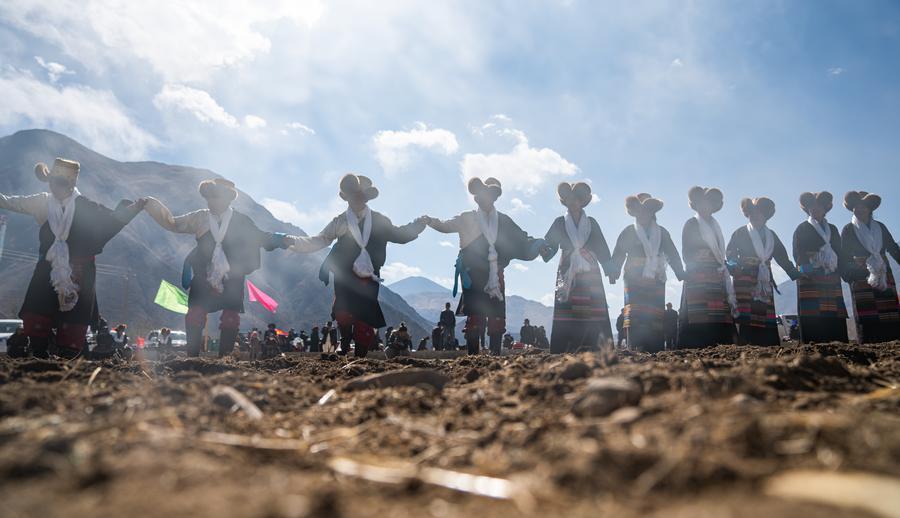
 0 Comment(s)
0 Comment(s) Print
Print E-mail Xinhua, April 8, 2024
E-mail Xinhua, April 8, 2024

Farmers sing during a ceremony marking the start of spring farming in Doilungdeqen district of Lhasa, southwest China's Xizang Autonomous Region, March 16, 2024. (Xinhua/Tenzin Nyida)
In Lhasa, the capital of southwest China's Xizang Autonomous Region, a remarkable event unfolded at the Dakpo astronomical observatory -- a structure with a history of over 300 years.
Clad in traditional Tibetan costumes, villagers gathered near the observatory in Maizhokunggar County, while a group of pupils from a nearby school were present to witness the event.
At precisely 9:50 a.m., sunlight pierced the rooftop aperture, illuminating a stone marker 29 meters away. This alignment symbolized the arrival of the spring irrigation period for the region east of the Lhasa River.
"Astronomical observations guide agricultural practices, corresponding to the timing recorded in the Tibetan annual almanac for 2024 regarding spring plowing and irrigation," explained Norbu Dondrup, an expert in astronomical calculations at the University of Tibetan Medicine.
He added that similar astronomical time-measuring devices can be found worldwide.
Kunsang, a fifth grader, was making his second visit to the observatory. "The expert's detailed explanations ignited my curiosity in traditional astronomical calculations," he said.
"Our traditional astronomical observatory informs us when to commence spring irrigation," said 56-year-old local villager Sonam Tseten, who was busy diverting water for irrigation.
He has been visiting the observatory every year since childhood, witnessing great changes in his hometown. The once treacherous mountain paths have been transformed into convenient highways, and in 2009, the observatory was reinforced with concrete.
However, their traditional customs remain unchanged. Every household in the village still adheres to the traditional Tibetan calendar. Furthermore, many young people are using Tibetan calendar smartphone apps to learn about and preserve this cultural heritage, he said.
During his childhood, devoid of smartphones and televisions, Norbu Dondrup found solace and entertainment in the vast expanse of the night sky.
Elders narrated tales of the stars, weaving myths such as that of the demon king's decapitated head being transformed into constellations after he was slain by King Gesar. Such myths sparked Norbu Dondrup's curiosity about space.
His fascination with astronomy and calendar calculations grew during his university days, and it has become a lifelong pursuit.
In traditional practices, experts in astronomical calculations would perform calculations on sand tables before verifying the accuracy of their predictions based on the sunlight received at the Dakpo astronomical observatory.
"Nowadays, we not only rely on traditional sand tables and observatories, but also utilize technologies like computers and telescopes to enhance the precision of the Tibetan calendar, allowing us to chart the vast starry sky with clarity," said Norbu Dondrup.
With a history of over 2,000 years, Tibetan astronomy and the calendar are a significant component of Tibetan culture. Even today, in most rural areas of Xizang, the timing for spring plowing is determined according to the Tibetan calendar derived from astronomical calculations.
In 2008, Tibetan astronomy and the calendar were included in the list of national intangible cultural heritage, helping to ensure this fascinating aspect of Tibetan culture continues to shine long into the future.
Go to Forum >>0 Comment(s)